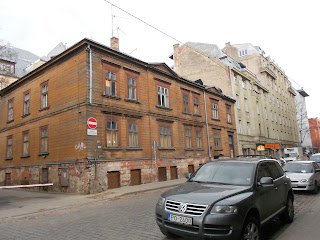And so by plane to Latvia via Munich, and whereas last year there was a lengthy delay in passing through customs, which culminated with hundreds of people missing their flights all was well this time. And in spite of the upheavals caused by the immigrants from the east, it was a relatively easy straightforward process with little if any delays in the process.
These are some of the old buildings which stand empty in the main city area which quite intrigued me. Upon questioning my friend Aigus, I was informed that the people who owned these buildings were mostly not able to afford the financial out-lay to refurbish them, and the local authorities could not make them do so.
Quite often nearby were beautifully renovated buildings as can be seen in the following photos.
This is one of the many wooden structures which has been re-furbished, and as can be seen is decidedly attractive, and pleasing to the eye.
In amongst these magnificent old buildings is to be found a lone Lutheran church.
The Evangelical Lutheran Church of Latvia (Latvian: Latvijas evaņģēliski luteriskā baznīca, or LELB) is a LutheranProtestant church in Latvia. Latvia's Lutheran heritage dates back to the Reformation. Both the Nazi and communistregimes persecuted the church harshly before religious freedom returned to Latvia in 1988.
The Evangelical Lutheran Church of Latvia sees itself as being in a continuous tradition of Christian life since the earliest recorded Christian missionary work in the area, in the 12th century.[1] Latvia was highly influenced by the Reformationand the style of Lutheran church which emerged followed the more Protestant German-type Lutheranism, rather than the episcopal or Nordic-type Lutheranism that emerged in Sweden, Denmark, Estonia and Finland. However, following the establishment of the Republic of Latvia (1918) the church moved towards a more historical catholic polity, and accepted consecration of bishops by the Church of Sweden. Along with the Church of Sweden, the ELCL now claims full apostolic succession. In 1975 the church decided to ordain women as pastors,[citation needed] but since 1993, under the leadership of Archbishop Jānis Vanags, it no longer does so.
Since the fall of communism, the church has experienced massive growth and expansion. A special Synod in April 1989, following the return to post-communist independence, established a network of revived congregations, and put in place an almost entirely new leadership.[2]
The Nativity of Christ Cathedral (Latvian: Kristus Piedzimšanas pareizticīgo katedrāle, Russian: Христорождественский кафедральный собор), Riga, Latvia was built to a design by Nikolai Chagin and Robert Pflug in a Neo-Byzantine style between 1876 and 1883, during the period when the country was part of the Russian Empire. It is the largest Orthodox cathedral in the Baltic provinces built with the blessing of the Russian Tsar Alexander II on the initiative of local governor-general Pyotr Bagration and bishop Veniamin Karelin. The Nativity of Christ Cathedral is renowned for its icons, some of which were painted by Vasili Vereshchagin. During the First World War German troops occupied Riga and turned its largest Russian Orthodox cathedral into a Lutheran church. In independent Latvia, the Nativity of Christ Cathedral once again became an Orthodox cathedral in 1921. Archbishop Jānis Pommers, a native Latvian, played a key part in the defence of the cathedral, including defence from the Latvian government which was extremely unfriendly to Orthodox Church in the first years of an independent Latvia. In the early 1960s, Soviet authorities closed down the cathedral and converted its building into a planetarium. The cathedral has been restored since Latvia regained independence from the Soviet Union in 1991.
Here we see more of the historic buildings which have been beautifully restored.












No comments:
Post a Comment